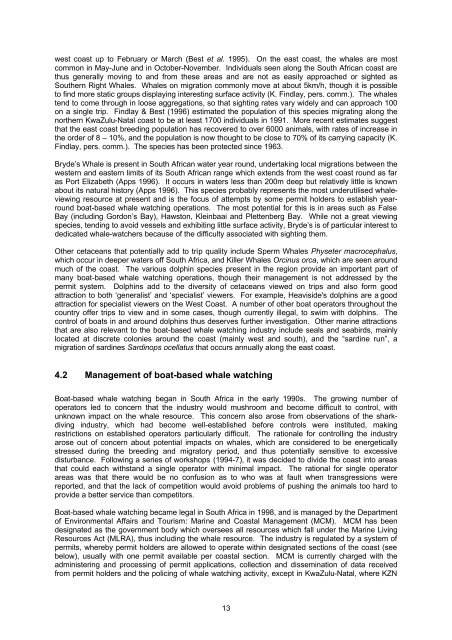Download PDF (2.5MB) - Anchor Environmental
Download PDF (2.5MB) - Anchor Environmental
Download PDF (2.5MB) - Anchor Environmental
You also want an ePaper? Increase the reach of your titles
YUMPU automatically turns print PDFs into web optimized ePapers that Google loves.
west coast up to February or March (Best et al. 1995). On the east coast, the whales are most<br />
common in May-June and in October-November. Individuals seen along the South African coast are<br />
thus generally moving to and from these areas and are not as easily approached or sighted as<br />
Southern Right Whales. Whales on migration commonly move at about 5km/h, though it is possible<br />
to find more static groups displaying interesting surface activity (K. Findlay, pers. comm.). The whales<br />
tend to come through in loose aggregations, so that sighting rates vary widely and can approach 100<br />
on a single trip. Findlay & Best (1996) estimated the population of this species migrating along the<br />
northern KwaZulu-Natal coast to be at least 1700 individuals in 1991. More recent estimates suggest<br />
that the east coast breeding population has recovered to over 6000 animals, with rates of increase in<br />
the order of 8 – 10%, and the population is now thought to be close to 70% of its carrying capacity (K.<br />
Findlay, pers. comm.). The species has been protected since 1963.<br />
Bryde’s Whale is present in South African water year round, undertaking local migrations between the<br />
western and eastern limits of its South African range which extends from the west coast round as far<br />
as Port Elizabeth (Apps 1996). It occurs in waters less than 200m deep but relatively little is known<br />
about its natural history (Apps 1996). This species probably represents the most underutilised whaleviewing<br />
resource at present and is the focus of attempts by some permit holders to establish yearround<br />
boat-based whale watching operations. The most potential for this is in areas such as False<br />
Bay (including Gordon’s Bay), Hawston, Kleinbaai and Plettenberg Bay. While not a great viewing<br />
species, tending to avoid vessels and exhibiting little surface activity, Bryde’s is of particular interest to<br />
dedicated whale-watchers because of the difficulty associated with sighting them.<br />
Other cetaceans that potentially add to trip quality include Sperm Whales Physeter macrocephalus,<br />
which occur in deeper waters off South Africa, and Killer Whales Orcinus orca, which are seen around<br />
much of the coast. The various dolphin species present in the region provide an important part of<br />
many boat-based whale watching operations, though their management is not addressed by the<br />
permit system. Dolphins add to the diversity of cetaceans viewed on trips and also form good<br />
attraction to both ‘generalist’ and ‘specialist’ viewers. For example, Heaviside's dolphins are a good<br />
attraction for specialist viewers on the West Coast. A number of other boat operators throughout the<br />
country offer trips to view and in some cases, though currently illegal, to swim with dolphins. The<br />
control of boats in and around dolphins thus deserves further investigation. Other marine attractions<br />
that are also relevant to the boat-based whale watching industry include seals and seabirds, mainly<br />
located at discrete colonies around the coast (mainly west and south), and the “sardine run”, a<br />
migration of sardines Sardinops ocellatus that occurs annually along the east coast.<br />
4.2 Management of boat-based whale watching<br />
Boat-based whale watching began in South Africa in the early 1990s. The growing number of<br />
operators led to concern that the industry would mushroom and become difficult to control, with<br />
unknown impact on the whale resource. This concern also arose from observations of the sharkdiving<br />
industry, which had become well-established before controls were instituted, making<br />
restrictions on established operators particularly difficult. The rationale for controlling the industry<br />
arose out of concern about potential impacts on whales, which are considered to be energetically<br />
stressed during the breeding and migratory period, and thus potentially sensitive to excessive<br />
disturbance. Following a series of workshops (1994-7), it was decided to divide the coast into areas<br />
that could each withstand a single operator with minimal impact. The rational for single operator<br />
areas was that there would be no confusion as to who was at fault when transgressions were<br />
reported, and that the lack of competition would avoid problems of pushing the animals too hard to<br />
provide a better service than competitors.<br />
Boat-based whale watching became legal in South Africa in 1998, and is managed by the Department<br />
of <strong>Environmental</strong> Affairs and Tourism: Marine and Coastal Management (MCM). MCM has been<br />
designated as the government body which oversees all resources which fall under the Marine Living<br />
Resources Act (MLRA), thus including the whale resource. The industry is regulated by a system of<br />
permits, whereby permit holders are allowed to operate within designated sections of the coast (see<br />
below), usually with one permit available per coastal section. MCM is currently charged with the<br />
administering and processing of permit applications, collection and dissemination of data received<br />
from permit holders and the policing of whale watching activity, except in KwaZulu-Natal, where KZN<br />
13
















